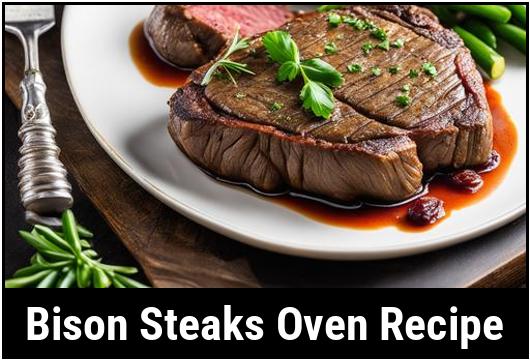
Bison Steaks Oven Recipe: A Savory Delight
Are you looking to indulge in a succulent, flavorsome, and healthy dish? Look no further! Our comprehensive guide to cooking bison steaks in the oven will satisfy your cravings and leave you craving more. Bison meat, known for its lean, tender, and rich flavor, is a versatile alternative to traditional beef. In this article, we will delve into food science, culinary techniques, selection, cleaning, preparation, cooking tips, variations, doneness checks, recipes, and even explore what happens when you overcook or undercook bison steaks. So, let’s get started on this culinary adventure!
The Food Science Behind Bison Steaks
Understanding the science behind cooking bison steaks will help you elevate your culinary skills and ensure optimal results. Bison meat is leaner than beef, with less fat marbling throughout the cut. This leanness contributes to its exceptional tenderness and unique flavor. However, due to its lower fat content, bison steaks tend to cook faster than beef steaks and can become tough if not handled with care.
Culinary Details: Choosing the Perfect Bison Steaks
Selecting high-quality bison steaks is crucial for a delectable outcome. When purchasing bison steaks, look for cuts that are well-marbled, evenly colored, and have a firm texture. The marbling, where the fat is dispersed within the meat, will add moisture and flavor during cooking.
Opt for cuts like ribeye or striploin, which are well-suited for oven preparation. These cuts are known for their tenderness and rich marbling, guaranteeing a juicy and flavorful bison steak.
Cleaning and Preparation: A Prelude to Perfection
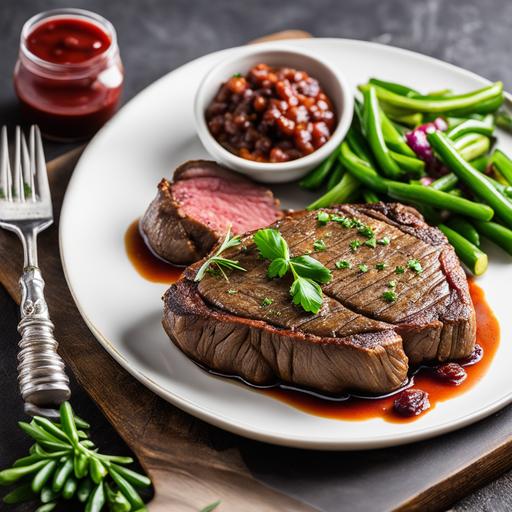
Before diving into the cooking process, it is essential to clean and prepare your bison steaks properly. Start by inspecting the steaks for any visible connective tissue or excess fat. Trim away any undesirable parts, but be cautious not to remove too much fat, as it contributes to the succulence of the steak.
Once trimmed, pat the steaks dry using paper towels. Excess moisture on the surface can hinder browning and searing, resulting in a less appealing appearance.
Tips and Techniques: Unlocking the Flavors
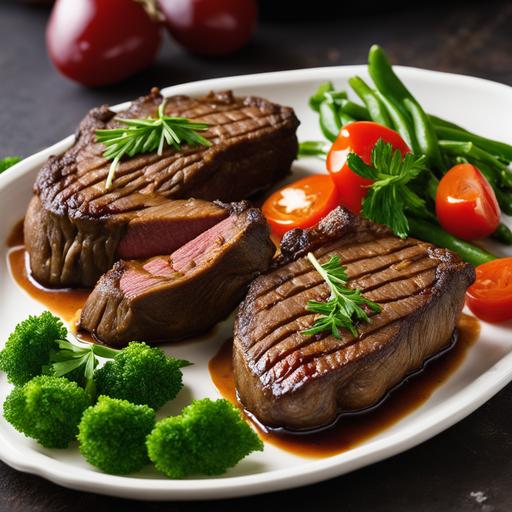
To achieve a delectably cooked bison steak, mastering a few essential techniques is necessary. Here are some tips and tricks to elevate your bison steak cooking game:
1. Bring the steaks to room temperature before cooking:
Allowing the steaks to reach room temperature promotes even cooking. Take the steaks out of the refrigerator at least 30 minutes before cooking to ensure proper heat penetration during cooking.
2. Seasoning: Keeping it Simple
Bison steaks boast a natural robustness that shines through with simple seasoning. Before cooking, generously season both sides of the steaks with salt and pepper or a dry rub of your choice. This allows the flavors of the meat to shine without overpowering its natural taste.
3. Preheating your oven to the right temperature:
To ensure an even cook, preheat your oven to 375°F (190°C). This temperature allows the meat to cook through gently while forming a delicious caramelized crust.
4. Searing: A Burst of Flavor
Searing your bison steaks before placing them in the oven adds a delightful crust and a burst of flavor. In a hot skillet, sear each side of the steak for approximately two minutes, until a golden brown crust develops.
5. Oven Cooking: Low and Slow
Place the seared bison steaks on a rack in a roasting pan and transfer them to the preheated oven. Cook the steaks for approximately 6-8 minutes per side, depending on your preferred level of doneness.
Doneness Checks: Mastering the Art of Timing
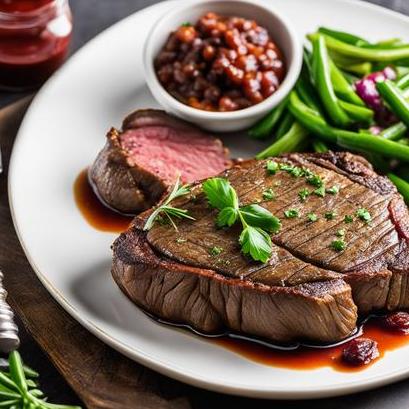
Checking the doneness of your bison steaks is crucial to ensure they are cooked to perfection. To determine the desired level of doneness, you can employ the following methods:
1. Visual Inspection:
A visual inspection can provide a general idea of your bison steak’s doneness. The color and texture of the meat change as it cooks. For rare, the meat will appear dark red and feel soft to the touch. Medium-rare is achieved when the meat is pink in the center and slightly firmer, whereas medium steaks will possess a more pronounced pink center and firmer texture.
2. Meat Thermometer:
For precise results, using a meat thermometer is highly recommended. The internal temperatures for various doneness levels are as follows:
-
Rare: 120°F (49°C)
-
Medium Rare: 130°F (54°C)
-
Medium: 140°F (60°C)
-
Medium Well: 150°F (66°C)
-
Well Done: 160°F (71°C)
Insert the probe of the meat thermometer into the thickest part of the steak without touching the bone for an accurate reading.
Recipe: Bison Steak Oven Perfection
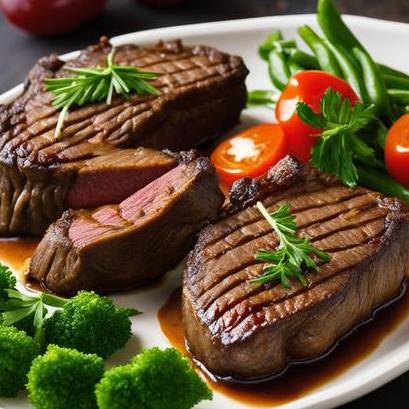
Now that you are equipped with all the necessary knowledge, it’s time to put it into practice by following our bison steak oven recipe. This recipe serves as a basic guideline, allowing you to experiment with flavors and make it your own.
Ingredients:
-
2 Bison steaks (ribeye or striploin)
-
Salt and pepper to taste
Instructions:
-
Preheat the oven to 375°F (190°C).
-
Bring the bison steaks to room temperature and pat them dry using paper towels.
-
Season both sides of the steaks generously with salt and pepper or your preferred dry rub.
-
In a hot skillet, sear each side of the steak for approximately two minutes or until golden brown.
-
Transfer the seared bison steaks to a rack in a roasting pan and place them in the preheated oven.
-
Cook the steaks for 6-8 minutes per side, depending on your desired level of doneness.
-
Once cooked to your liking, remove the steaks from the oven and let them rest for a few minutes before serving.
Overcooking and Undercooking: Balance is Key
While bison steaks are incredibly flavorful, they can quickly become tough and dry if overcooked or undercooked. Understanding the consequences of overcooking and undercooking will help you avoid these pitfalls and savor the juiciness of perfectly cooked bison steaks.
Overcooking:
Overcooking bison steaks causes the proteins to tighten and squeeze out moisture, resulting in a dry and tough texture. To prevent overcooking, monitor the cooking time carefully and use a meat thermometer to achieve the desired level of doneness. Remember that bison steaks cook faster than their beef counterparts, so vigilance is key.
Undercooking:
Undercooked bison steaks may not be safe to consume due to potential bacteria, such as E. coli or salmonella. Ensure you reach the minimum internal temperatures mentioned earlier to ensure food safety. Remember, it’s always better to be safe than sorry.
Exploring Variations: Unleashing Your Culinary Creativity
While a perfectly cooked bison steak is delightful on its own, experimenting with various flavor profiles allows you to unleash your culinary creativity. Consider exploring these variations to enhance your bison steak experience:
1. Marinades:
Marinating bison steaks adds an extra layer of flavor and helps tenderize the meat. Choose your favorite marinade recipe, whether it’s a mixture of herbs, spices, or a savory sauce, to infuse the bison steaks with unique flavors.
2. Compound Butter Toppings:
Create a compound butter by combining herbs, spices, or even roasted garlic with softened butter. After cooking your bison steaks, allow a pat of compound butter to melt over the hot meat, adding a burst of aromatic flavors.
3. Sides and Pairings:
Pair your bison steak with complementary sides such as a medley of roasted vegetables, a fresh green salad, or garlic mashed potatoes. Opt for a robust red wine or a craft beer to complete the culinary experience.
Conclusion
Cooking bison steaks in the oven is a rewarding gastronomic adventure that showcases the unique flavors and tenderness of this remarkable meat. Armed with knowledge about food science, culinary techniques, selection, cleaning, preparation, cooking tips, variations, doneness checks, and even the consequences of overcooking and undercooking, you are ready to embark on this journey.
Remember, bison steaks require a delicate touch, a keen eye, and an adventurous spirit. With our comprehensive guide, you can be confident in creating perfectly cooked bison steaks that will delight your taste buds and elevate your culinary repertoire. So, put on your apron, fire up the oven, and savor the exceptional delights of bison steaks!
FAQS On Bison Steaks Oven Recipe
What Is The Best Way To Season Bison Steaks?
Bison steaks are lean and flavorful, so a simple seasoning of salt and pepper is often enough. However, you can add in other seasonings such as garlic, herbs, and spices to enhance the flavor. A marinade of acid-based ingredients like lemon juice or vinegar can also help tenderize the meat.
How Long Should I Cook Bison Steaks In The Oven?
The cooking time for bison steaks will depend on the thickness of the steak and your desired level of doneness. As a general rule, you can cook a 1-inch thick steak for 8-10 minutes for medium-rare, and 10-12 minutes for medium. A thicker steak will require longer cooking time.
What Temperature Should The Oven Be Set To For Cooking Bison Steaks?
It is recommended to preheat your oven to 425°F for cooking bison steaks. This high temperature will help create a nice crust on the outside of the steak while keeping the inside juicy and tender.
Can I Use A Cast Iron Skillet To Cook Bison Steaks In The Oven?
Yes, a cast iron skillet is a great option for cooking bison steaks in the oven. It can handle high heat and helps distribute the heat evenly, resulting in a perfectly cooked steak. Just make sure to preheat the skillet in the oven before adding the steaks.
How Can I Tell If The Bison Steak Is Cooked To My Desired Level Of Doneness?
The best way to determine the doneness of a bison steak is to use a meat thermometer. For a medium-rare steak, the internal temperature should read 135°F, while a medium steak should be around 145°F. You can also use the touch method – a medium-rare steak will feel slightly firm and springy to the touch, while a medium steak will be firmer. It is not recommended to rely on visual cues alone as the color of bison meat can be darker than beef, making it difficult to judge doneness by color.


